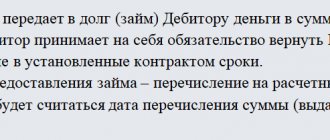Interest-free loan: basic provisions
The issuance of interest-free loans to employees is regulated by the Civil Code, namely the 1st paragraph of Chapter 42. The subject of the loan can be both money and things. In this case, an agreement must be concluded in writing between the employer and the employee (Article 808 of the Civil Code of the Russian Federation). The contract must state that the loan is interest-free. Otherwise, the default interest rate will be equal to the refinancing rate (Article 809 of the Civil Code of the Russian Federation). However, there are exceptions. If the agreement of the parties does not contain a word about interest, then the loan will be considered interest-free when:
- the agreement was concluded between citizens for an amount less than or equal to 50 minimum wages, not for business purposes;
- Things are given on loan.
In addition, the contract must specify the return period. If such a date is not specified, the borrower must be prepared to repay the debt within 30 days after receiving a request to do so. Also, at his discretion, an employee can repay an interest-free loan (hereinafter referred to as the LO) ahead of schedule.
Procedure for issuing a loan to an employee
When providing a loan to an employee, an agreement must be drawn up. According to it, the employer transfers a certain amount of money to the employee, which the latter is obliged to return. When drawing up a loan agreement, the following points should be taken into account:
- Form of agreement. The agreement must be drawn up in writing.
- Date of entry into force of the agreement. This date will determine when the transfer of money to the employee actually occurred.
- Sum. The loan amount is specified in the agreement. The law does not establish restrictions on the size of the loan, but if an employer issues a large loan to an employee (from 25% of the value of the property), then the decision to issue it is made not by the manager, but by the participants (shareholders or board of directors) of the company.
- Currency. Loans in foreign currency can only be issued by credit organizations, so rubles must be specified as the currency in the agreement.
- Interest on the use of borrowed funds. An interest rate may be provided, but the employer can also issue an interest-free loan. If the interest rate is not specified in the agreement, then by default it will be equal to the refinancing rate established at the time of repayment of the borrowed funds or only part of it. If an employer is ready to provide its employee with an interest-free loan, then this condition must be specified in the contract. This can be done as follows: “no interest is accrued for the use of borrowed funds under this agreement.”
- Loan term and repayment procedure. If the specified conditions are not specified in the agreement, then the borrower must pay interest monthly and repay the loan no later than 30 days after the lender submits the request.
- Early repayment. If the conditions for repaying the loan ahead of schedule are not provided for in the agreement, then the interest-free loan can be repaid at any time, and the interest-bearing loan can be returned no earlier than 30 days after submitting to the lender a notice of repayment of the loan ahead of schedule.
An agreement is drawn up in any form. The basis for its registration may be a statement from the employee. The agreement should also stipulate the term and method of issuing the loan. Money can be issued from the employer's cash desk or transferred to the employee's account. In addition, the method of returning the money is indicated, for example, by deducting from the employee’s salary, depositing it in the cash register, or transferring it to the employer’s account.
Important! It is important to indicate in the contract the purpose for which the loan is provided to the employee. The procedure for assessing personal income tax on the employee’s benefits when using a loan will depend on it.
An interest-free loan was issued: accounting
Let's consider what entries an accountant should make for an interest-free loan to an employee. For settlements of loans to employees, the chart of accounts approved by Order of the Ministry of Finance of the Russian Federation dated October 31, 200 No. 94n provides for account 73.
| Description | Dt | CT | Documentation |
| Posting for issuing an interest-free loan to an employee in cash | 73.1 | 50 (51) | Expenditure cash order (payment order, bank statement) |
| Posting for repayment of cash balance by employee | 50 (51) | 73.1 | Receipt cash order (payment order, bank statement) |
The financial investment account is not used in transactions for interest-free loans issued to employees; this is indicated in the instructions for the chart of accounts for account 58. It is also necessary to pay attention to the reflection of transactions for personal income tax, which must be paid if the employer does not charge interest on the loan. Read more about personal income tax in the following sections.
| Description | Dt | CT | Documentation |
| Personal income tax withheld from income from non-payment of interest on the loan | 70 | 68 | Tax registers |
| Personal income tax is transferred to the budget | 68 | 51 | Payment order, bank statement |
Wiring
The issuance of borrowed funds to employees of the organization must be reflected in account 73-1 “Settlements on loans provided.”
All operations on borrowed funds are reflected:
- debit 73-1, credit 50 (51) issuance of borrowed funds;
- debit 73-1, credit 91-1 interest accrual;
- debit 51 (50), credit 73-1 repayment through the cash register or current account;
- debit 70, credit 68 withholding personal income tax from the benefits received by the employee.
Calculations and corresponding entries must be reflected in the accounting records every month.
Taxation of material benefits
The MV amount is the tax base for personal income tax (Article 210 of the Tax Code of the Russian Federation). The tax is calculated at a rate of 35% for residents and 30% for non-residents (clauses 2–3 of Article 224 of the Tax Code of the Russian Federation). Thus, from the employee’s income, which the employer pays him monthly, the corresponding percentage of personal income tax from his MV from the BZ must be withheld. The amount of deduction cannot be more than 50% of income in cash, which is paid this month (clause 4 of article 226 of the Tax Code of the Russian Federation). If the withholding amount exceeds the maximum, the balance is carried over to the next month. If it was not possible to withhold personal income tax during the tax period, the employer must inform both the tax office and the employee about this by sending them a 2-NDFL certificate. The employer pays the withheld personal income tax on the day of payment of income or the next (clause 6 of Article 226 of the Tax Code of the Russian Federation); personal income tax cannot be paid in advance (clause 9 of Article 226 of the Tax Code of the Russian Federation).
An example of calculating personal income tax from the material benefit of saving on interest with an interest-free ruble loan from ConsultantPlus. On June 5, 2021, the employer issued the employee Romashkina V.V. (tax resident of the Russian Federation) interest-free loan in the amount of 130,000 rubles. until August 1, 2021. The employee transferred the entire loan amount to the organization’s account on July 31, 2021. The refinancing rate of the Bank of Russia during this period is 7.5% (conditionally). The employer calculated personal income tax on material benefits as follows. You can view the entire example in K+ by getting free trial access.
Taxation procedure for an employee on a loan from an organization
If a gratuitous loan agreement is concluded, the employer does not derive financial benefits from this transaction. Consequently, there is no basis for charging tax.
An employee who receives borrowed funds on an interest-free basis from his employer benefits from savings on interest payments. This entails taxation of the income thus obtained.
Upon issuance of an interest-free loan, the employer is obliged to perform the following operations:
- calculate personal income tax at the rate of 35% of the amount saved on interest during the entire borrowing period (monthly);
- withhold tax from the borrower's income, but not more than half of the salary;
- transfer personal income tax to the budget monthly.
The tax is calculated on the last day of the month, and the withheld amount is transferred to the budget on the next day after the calculation.
It is important to take into account those cases where tax is not charged. These include the following loans received for specific purposes:
- A cash loan received for the construction of a new home or the purchase of an apartment, house, share or room in a secondary building. The tax is not charged if the funds are used to purchase a plot of land for the subsequent construction of a residential building.
- The loan was received by the borrower in order to refinance a targeted loan taken for the purchase or construction of individual housing.
Interest-free loan for home purchase
Taxation of personal income tax for MV has exceptions specified in subsection. 1 clause 1 art. 212 of the Tax Code of the Russian Federation. One of them is that if the purpose of the BP is defined as the construction or acquisition of housing in our country, as well as land for its construction, then the MV for such BP is not recognized as income. In this case, the employee to whom such a work permit was issued must have the right to a property deduction. This deduction must be confirmed by a special notice issued by the tax authority, the form of which was approved by order of the Federal Tax Service of the Russian Federation dated January 14, 2015 No. ММВ-7-11/ [email protected]
Thus, until the employee brings the specified notice, the accountant withholds personal income tax from him every month from the MV according to the BZ. After confirmation of the right to a property deduction, personal income tax is not accrued, however, the employer cannot return previously withheld personal income tax amounts, since they are not considered excessively withheld in accordance with clause 1 of Art. 231 Tax Code of the Russian Federation. You can return personal income tax amounts that were withheld before the notification was provided yourself at the tax office at your place of residence. Such clarifications are given in the letter of the Ministry of Finance of the Russian Federation dated March 21, 2013 No. 03-04-06/8790.
NOTE! Starting from 2021, financial benefits arising during mortgage holidays are not subject to personal income tax.
Personal income tax
When issuing a loan, the accountant will need to determine whether in this case there is a material benefit for the employee. Income (material benefit) appears if the loan interest rate is less than 2/3 of the refinancing rate established at the time of receipt of funds. If there is a material benefit, then it is subject to personal income tax at a rate of 35%, if the employee is a resident, if a non-resident, then at a rate of 30%.
The employee's material benefit is calculated as follows:
MV = 2/3 x StR x Z / 365 (366) x Dn , where
StR – refinancing rate established on the date of receipt of income;
Z – amount of borrowed funds;
Day – number of days of using borrowed funds in a month.
Important! The refinancing rate is taken in the amount valid on the last day of each month of using the loan. It is on this day that the employee earns income.
Tax is withheld from the employee on the day when he receives income in the form of a material benefit. If the loan is interest-free, then on the day the money is repaid, and if it is interest-bearing, then on the day the interest is repaid. If repayment occurs in installments, then the calculation is made on each payment date. Personal income tax is withheld from any payment closest to the date of payment to the employee.
Personal income tax is not imposed on the material benefit that an employee receives from saving on interest if the loan was issued to him for the construction of a new home or the purchase of housing within the Russian Federation, or for the purchase of a land plot, etc. (Article 212 of the Tax Code of the Russian Federation). In this case, the following conditions must be met:
- purpose of the loan;
- the employee must provide a letter from the tax office about obtaining the right to a property deduction, which will indicate the details of the loan agreement, as well as the employer who issued the loan.
Interest-free loan in kind: taxation
An employee’s knowledge book can be issued to the company’s goods, materials, fixed assets, etc. The things transferred must be defined by generic characteristics, that is, they cannot be unique with specific characteristics that only they have. A non-monetary loan can be repaid in money or the same things. The main qualities of the transferred items should be indicated in the contract (name, grade, quantity, size, etc.) so that the borrower returns the corresponding property.
When issuing this type of work permit, the employer must take into account some taxation nuances. As for income tax, the transfer of money or things as a loan is not considered an expense (clause 12 of Article 270 of the Tax Code of the Russian Federation), and repayment of the loan is not considered income (clause 10 of Article 251 of the Tax Code of the Russian Federation). Cash loans are not subject to VAT (subclause 15, clause 3, article 149 of the Tax Code of the Russian Federation). Under a non-monetary loan agreement, the employer's property becomes the property of the employee. In paragraph 1 of Art. 39 of the Tax Code of the Russian Federation, the sale is equated to the transfer of ownership of things, and, according to subparagraph. 1 clause 1 art. 146 of the Tax Code of the Russian Federation, the sale is called an object for VAT. Therefore, the transfer of things under the BZ agreement is subject to VAT. The price of the transferred property is determined as the current market price. When calculating such VAT, the employer has the right to deduct the corresponding input VAT that he paid when purchasing valuables transferred under the BZ.
Example 2
01/01/2020 V. A. Sokolov received ceramic tiles produced at the Voskhod LLC enterprise, where he works, as a BZ. The cost of the tiles was 135,000 rubles. without VAT. The loan term is 1 year. The employer must pay VAT to the budget in the amount of 135,000 rubles. × 20% = 27,000 rub.
How to get an interest-free loan for an employee
First of all, the employee must write an application addressed to the manager with a text that will correctly indicate for what purpose and what amount he is interested in.
After preliminary consideration and approval, the employee begins to prepare the necessary documents.
An interest-free loan agreement for the employee is drawn up. All his passport details, place of registration and residence, work experience, etc. are entered there.
The agreement is signed by the manager himself or a person authorized to sign such documents.
The company seal must be present. The signature of the chief accountant, because he maintains the accounting records of the entire company.
Both parties receive a copy of the agreement. MFO conditions:
| Organization | Amount of credit | Interest rate | Analysis time |
| Monesa | 60 thousand rubles. | 0,35 % | 15 minutes. |
| Turboloan | 15 thousand rubles. | 2,17 % | 5 minutes. |
| Lime | RUB 20,400 | 2,13 % | 5 minutes. |
For what purposes are funds issued?
Funds can be issued for any needs of an employee (Article 809 of the Civil Code of the Russian Federation):
- to buy a home, car,
- for a trip to the sea, on vacation,
- for treatment,
- for education.
If the contract specifically stated for what purposes the funds were needed, then the company has the right to subsequently request from the employee confirming certificates or documents stating that the funds were used for the specified purposes.
If a home was purchased, this may be a purchase and sale agreement. If the employee does not comply with the instructions upon the first request, the contract may be terminated.
Application example
How does an employee submit an application to an employer for a loan?
First of all, take a blank A4 sheet and fill in the “header” in the upper right corner - the position of the director and his initials, then from whom the application is made, your full name, position. Next in .
The main part of the application contains the request itself, namely “I ask you to provide me with a loan in the amount of...” and you write down in numerical format the amount of money you want to ask for.
It would also be useful to indicate the purpose of the request and the period for concluding the contract (a year, one and a half, two or more).
Indicate how you are going to pay off the debt, in what amounts it will be convenient for you to do this (minimum payments).
More often in practice, partial collection of debt from an employee’s salary is used in the accounting department when forming the next monthly salary payment.
How to fill out an online application at the Loan Bureau, see the article: Loan Bureau. How to get a Quick Loan on your card online, around the clock and with a bad credit history, read here.
At the end of the text, the date of the application is indicated at the bottom left and your signature with initials on the right. Then you need to register it with the secretary of the office. All that remains is to wait for a decision from management.
Procedure for concluding an agreement (sample)
A loan agreement for an employee is practically no different from a regular standard loan agreement.
The only distinctive feature is that the contract clearly states that the loan is interest-free. A form for an interest-free loan agreement is available.
Additional conditions may also include nuances that arose during the term of the contract, for example, if an employee quits, the manager may demand early payment of the debt.
The contract states the following:
- subject of the agreement/purpose;
- contract time;
- rights and obligations of the parties;
- liability of the parties;
- grounds and procedure for termination of the contract;
- resolution of disputes from the contract;
- force majeure situations and other conditions.
Upon completion, the data is indicated - registration, registration, passport and contact information. The signatures of the parties and the company seal of the company are required.
If necessary, the loan agreement is accompanied by an act of acceptance and transfer of the borrowed property, a payment schedule, which states what amount and at what time the borrower must repay the debt to the lender.
The agreement should spell out important aspects of the deal that have been agreed upon in advance.
If the agreement does not contain a repayment period, then the borrower must return the money no later than 30 days from the period when the loan repayment request was submitted to him.
If the borrower does not pay the debt on time, the lender may demand payment of the entire debt in one lump sum.
In addition, the standard loan agreement provides for different types of fines that will come into force in a situation of non-fulfillment or improper performance of its obligations by the borrower.
All changes to the loan agreement are made by agreement of the two parties and are confirmed by the signing of other agreements in addition to the main loan agreement.
Calculation of material benefits
The employee will receive financial benefits from the loan received:
| If the interest rate on the loan is below 2/3 of the refinancing rate | Which is valid on the date of interest payment (for loans in rubles) |
| If the rate on it is below 9 percent per year (for loans in foreign currency) | This situation may arise when issuing a loan to a foreigner |
| With a free loan | — |
Material benefit is calculated using the formula:
(2/3 * 8.25% * loan amount) * (actual number of days of using the loan / 365).
Interest-free loan in kind: accounting
The accounting value of the transferred assets may or may not correspond to their assessment in the business contract. If a difference exists, it will be reflected in other income or expenses. In accounting, transactions on business history are reflected as follows:
| Description | Dt | CT | Documentation |
| The book value of the property was written off when issuing a business license | 73.1 | 41 (01, 10…) | Transfer and acceptance certificate (invoice) |
| Income is reflected if the contract value is higher than the book value | 73.1 | 91.1 | Transfer and acceptance certificate (invoice) |
| An expense is reflected if the contract price is lower than the book value | 91.2 | 73.1 | Transfer and acceptance certificate (invoice) |
| VAT is charged on the amount of the loan issued by the property | 73.1 | 68 subaccount “VAT” | Invoice |
| Repayment of debt in kind with property or money | 41 (01, 10, 50, 51…) | 73.1 | Acceptance certificate (invoice), payment order, bank statement |
Example 2 (continued)
The book value of the tiles was 105,000 rubles. Let's assume that the refinancing rate did not change throughout the year and amounted to 9% (conditionally). Then the personal income tax amount will be equal to: 35% × 2/3 × 9% × 159,300 = 3,345 rubles. The accountant recorded the following entries:
| Description | Dt | CT | Sum |
| The book value of the property was written off when issuing a business license | 73.1 | 41 | 105 000 |
| The excess of the contract value over the book value is reflected | 73.1 | 91.1 | 30 000 |
| VAT is charged on the amount of the loan issued by the property | 73.1 | 68 subaccount “VAT” | 24 300 |
| BZ extinguished | 41 | 73.1 | 159 300 |
| Personal income tax withheld from MV according to BZ | 70 | 68 subaccount “NDFL” | 3 345 |
| Personal income tax is transferred to the budget | 68 subaccount “NDFL” | 51 | 3 345 |
Results
Currently, organizations are finding various ways to motivate employees; one of the options may be issuing a work permit. However, we must not forget that, despite the absence of interest, the employee will still incur associated expenses in the form of personal income tax with MV. And the responsibility for calculating and paying this tax to the budget lies with the employer.
Read about the BC for organizations in our article “Is an interest-free loan subject to income tax?”
You can find more complete information on the topic in ConsultantPlus. Free trial access to the system for 2 days.
When does material gain not occur?
The tax implications of an interest-free loan to an employee must be considered by each recipient of the funds. They consist in the need to pay personal income tax on the benefits received. But in some situations, material benefits do not arise. These include:
- funds are used to build a private house or purchase an apartment, as well as other residential real estate;
- the borrower has the right to apply for a property deduction, which allows you to reduce the amount of tax.
In other situations, you will have to pay personal income tax on the benefits received. For residents of the Russian Federation the rate is 13%, and for non-residents it is 30%.







